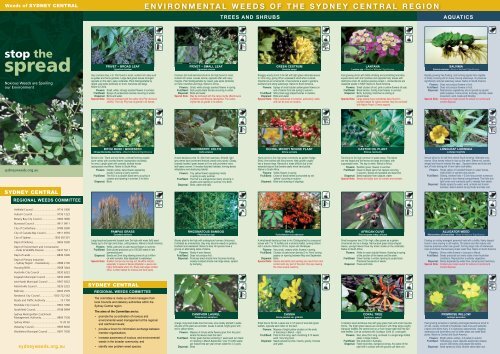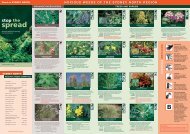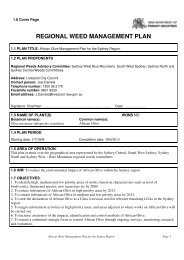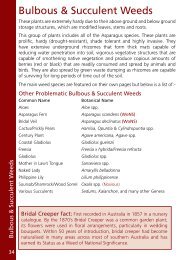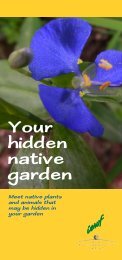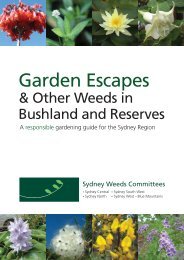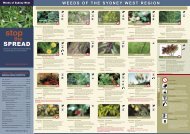spread - Sydney Weeds Committees
spread - Sydney Weeds Committees
spread - Sydney Weeds Committees
Create successful ePaper yourself
Turn your PDF publications into a flip-book with our unique Google optimized e-Paper software.
<strong>Weeds</strong> of SYDNEY CENTRAL<br />
e n v i r o n m e n t a l W e e d s o f t h e s y d n e y C E N T R A L r e g i o n<br />
trees and shrubs<br />
AQUATICS<br />
stop the<br />
<strong>spread</strong><br />
Privet – broad leaf<br />
Ligustrum lucidum<br />
Privet – small leaf<br />
Ligustrum sinense<br />
green cestrum<br />
Cestrum parqui<br />
Lantana<br />
Lantana spp – Weed of National Significance<br />
salvinia<br />
Salvinia molesta - Weed of National Significance<br />
Noxious <strong>Weeds</strong> are Spoiling<br />
our Environment<br />
Very common tree, 4 to 10m found in moist, nutrient rich sites such<br />
as gullies and home gardens. Large dark green leaves arranged<br />
opposite on the stem, paler underside. Plant distinguishable by<br />
raised, pale spots (lenticels) on trunk, branches and twigs.<br />
Native to China.<br />
Flowers: Small, white, strongly scented flowers in summer.<br />
Fruit/Seed: Sprays of purple-black berries occurring in winter.<br />
Dispersal: Birds and water.<br />
Special Note: May be confused with the native Lilly Pilly (Acmena<br />
smithii). The Lilly Pilly has oil glands in its leaves.<br />
Common tall multi-stemmed shrub to 3m high found in moist,<br />
nutrient rich areas. Leaves narrow, opposite often with wavy<br />
margins. Plant distinguishable by raised, pale spots (lenticels)<br />
on trunk, branches and twigs. Native to China.<br />
Flowers: Small, white strongly scented flowers in spring.<br />
Fruit/Seed: Dark purple-black berries occurring in winter.<br />
Dispersal: Birds and water.<br />
Special Note: May be confused with the native myrtle (Backhousia<br />
myrtifolia) and Breynia oblongifolia. The native<br />
myrtle has oil glands in its leaves.<br />
Straggly woody shrub 2-3m tall with light green alternate leaves<br />
to 12cm long, giving off an unpleasant smell when crushed.<br />
Imported as an ornamental, it has become a weed in gardens,<br />
bushland and along waterways. Native to South America.<br />
Flowers: Sprays of small tubular yellow-green flowers on<br />
end of stems from late spring to autumn.<br />
Fruit/Seed: Shiny black egg shaped berries in clusters.<br />
Dispersal: Birds and water.<br />
Special Note: Highly poisonous to livestock, particularly cattle,<br />
and can be toxic to humans.<br />
Fast growing shrub with brittle climbing and scrambling branches,<br />
square stems with short prickles and opposite hairy leaves with<br />
distinctive smell. All Lantana species except L. montevidensis are<br />
classified weeds in NSW. Native to South America.<br />
Flowers: Small clusters of red, pink or yellow flowers all year.<br />
Fruit/Seed: Black berries, fruiting most heavily in summer.<br />
Dispersal: Birds, dumping, branches re-rooting at<br />
ground level.<br />
Special Note: Large stands have sometimes been found to<br />
provide habitat for native animals. May be confused<br />
with Native Peach (Trema aspera).<br />
Rapidly growing free floating, mat forming aquatic fern capable<br />
of totally covering still or slowly moving waterways. Its presence<br />
significantly reduces waterway values. Native to South America.<br />
Flowers: Does not produce flowers or fruit.<br />
Fruit/Seed: Does not produce flowers or fruit.<br />
Dispersal: Reproduces vegetatively and is <strong>spread</strong> by aquatic<br />
plant suppliers, home ponds, dumping, animals, water<br />
movement, wind, boats and flooding.<br />
Special Note: Contact your local council for advice on control and<br />
correct disposal.<br />
Bitou Bush / Boneseed<br />
Chrysanthemoides monilifera – Weed of National Significance<br />
Hackberry, Celtis<br />
Celtis sinensis<br />
Ochna, Mickey Mouse Plant<br />
Ochna serrulata<br />
Castor Oil Plant<br />
Ricinus communis<br />
Longleaf Ludwigia<br />
Ludwigia longifolia<br />
sydneyweeds.org.au<br />
SYDNEY CENTRAL<br />
Shrub to 2m. There are two forms: a thicket forming coastal<br />
dune variety with rounded leaves (subspecies rotundata).<br />
An erect, upright plant with coarsely toothed leaves<br />
(subspecies monilifera). Native to South Africa.<br />
Flowers: Golden yellow, daisy flowers appearing<br />
mostly in spring to early summer.<br />
Fruit/Seed: The fruit is a purplish black berry occuring in<br />
clusters and ripening in summer, 6 to 8mm.<br />
Dispersal: Birds<br />
A semi-deciduous tree 12- 20m from east Asia. Smooth, light<br />
grey stems have prominent lenticels (small corky spots). Glossy,<br />
coarsely toothed, green leaves to 8 cm with prominent veins,<br />
leaf bases uneven. It invades disturbed habitats, forming dense<br />
infestations and destroying habitat.<br />
Flowers: Tiny yellow flowers appearing mostly<br />
in spring to early summer.<br />
Fruit/Seed: The fruit is a orange-brown berry occuring in<br />
clusters and ripening in summer, 6 to 8mm.<br />
Dispersal: Birds, water and bats.<br />
Hardy shrub to 2m high grown commonly as garden hedge.<br />
Shiny, fine toothed and wavy leaves. New growth usually<br />
has a bronze tinge. Removal is made difficult due to the<br />
extended taproot that breaks easily when hand pulled.<br />
Native to South Africa.<br />
Flowers: Yellow flowers in spring.<br />
Fruit/Seed: Crown of black berries surrounded by red<br />
“petals” occurring in autumn.<br />
Dispersal: Birds and dumping of clippings.<br />
Tall shrub to 3m high common in waste areas. The stems<br />
are red tinged and the leaves are large and lobed, with<br />
suppressed veins. The sap is white. Native to Africa.<br />
Flowers: Reddish green, flowers in summer.<br />
Fruit/Seed: Green to black spiny fruit capsule occuring<br />
in autumn. Seeds are speckled and bean-like.<br />
Dispersal: Seed explosion from capsule, water.<br />
Special Note: Seeds are highly toxic to humans and animals.<br />
Annual shrub to 3m tall from central South America. Alternate long,<br />
narrow 15cm leaves reduce in size up the stem. Stems red, narrow,<br />
winged and branch towards the apex. Squared stems and fruits and<br />
lack of hairs distinguish it from native look-alikes.<br />
Flowers: Single yellow 4-5 petalled flowers in upper leaves,<br />
most prolific in summer and autumn.<br />
Fruit/Seed: Oblong, hairless fruits 1-3.5cm long contain numerous<br />
tiny seeds in four internal compartments. The fruits turn<br />
light brown and eventually split to release their seeds.<br />
Dispersal: Seeds <strong>spread</strong> by water, wind, animals and human<br />
activities. Stems detach during floods and take root.<br />
regional weeds committee<br />
Ashfield Council.................................9716 1800<br />
Auburn Council.................................9735 1222<br />
Botany Bay City Council.....................9366 3666<br />
Burwood Council...............................9911 9911<br />
City of Canterbury.............................9789 9300<br />
City of Canada Bay Council...............9911 6555<br />
City of <strong>Sydney</strong>................................1300 651301<br />
Dept of Defence................................9605 5590<br />
Dept of Environment and Conservation<br />
– Parks & Wildlife Division..................9337 5511<br />
Dept of Lands....................................8836 5300<br />
Dept of Primary Industries<br />
– <strong>Sydney</strong> Region - Hawkesbury..........4588 2100<br />
Housing NSW....................................9268 3444<br />
Hurstville City Council........................9330 6222<br />
Pampas Grass<br />
Cortaderia selloana<br />
Large long-lived perennial tussock over 2m high with many fluffy seed<br />
heads (up to 3m high) and sharp, cutting leaves. Native to South America.<br />
Flowers: White, pale pink or pale mauve flowers in summer.<br />
Fruit/Seed: Each plume produces up to 100,000 seeds in late<br />
summer/autumn.<br />
Dispersal: Seeds are 2mm long allowing travel of up to 40km<br />
on wind currents. Also dispersed in waterways.<br />
Special Note: Smaller clumps can be dug out. Bushfire Hazard,<br />
especially in areas of dense infestation. Leaves are<br />
highly flammable when dry. Sharp leaf edges contain<br />
silica. Is often habitat for snakes and feral pests.<br />
RHIZOMATOUS BAMBOO<br />
Phyllostachys spp<br />
Woody plant to 6m high with underground runners (rhizomes).<br />
Cultivated as ornamentals, they may become weeds in gardens,<br />
bushland and wasteland. Native to Asia. All species have a<br />
groove on alternating sides of stems.<br />
Flowers: Rarely if ever flowers<br />
Fruit/Seed: Does not produce fruit<br />
Dispersal: Produces erect shoots from rhizomes forming<br />
loosely clumped shoots over large areas, <strong>spread</strong><br />
by dumping.<br />
Rhus<br />
Toxicodendron succedaneum<br />
A shrub/small deciduous tree to 4m. Distinguished by compound<br />
leaves with 7 to 10 leaflets and a terminal leaflet, turning brilliant<br />
red in autumn. Native to China, Japan and Himalayas.<br />
Flowers: Very small, creamy white, flowers in spring.<br />
Fruit/Seed: Clusters of pale brown berries (5 to 7mm) turning<br />
papery on ripening between May and September.<br />
Dispersal: Birds<br />
Special Note: Severe dermatitis and swelling can result from skin<br />
contact with any part of the plant (the sap causing<br />
the most severe reaction).<br />
AFRICAN OLIVE<br />
Olea europaea subsp. africana<br />
Small evergreen tree 2-15m high, often grown as a garden<br />
ornamental and as a hedge. Narrow,dark green lance-shaped<br />
leaves, younger leaves have tiny brown scales on the underside.<br />
Native to South Africa.<br />
Flowers: White to cream tubular flowers, flowering in spring<br />
at the junction of the leaves and the stem.<br />
Fruit/Seed: Green berries in winter ripening to purple-black.<br />
Produces thousands of seeds.<br />
Dispersal: Foxes and birds.<br />
Alligator Weed<br />
Alternanthera philoxeroides - Weed of National Significance<br />
Floating or rooting emergent perennial herb with a brittle, fleshy taproot<br />
found in slow moving or still waters. Old stems lose their leaves and<br />
become prostrate under new growth, forming large mats of interwoven<br />
roots and stems that seriously impair water flow. Native to South America<br />
Flowers: Silvery white flowers in January to March.<br />
Fruit/Seed: Seeds produced but rarely viable under Australian<br />
conditions. Reproduction is entirely vegetative.<br />
Dispersal: Stems dispersed by water flow, dumping and machinery.<br />
Special Note: Contact your local council for advice on control and<br />
correct disposal.<br />
Kogarah Municipal Council................9330 9400<br />
Leichhardt Municipal Council.............9367 9222<br />
Marrickville Council............................9335 2222<br />
SYDNEY CENTRAL<br />
RailCorp.............................................8202 2535<br />
Randwick City Council..................1300 722 542<br />
Roads and Traffic Authority....................13 1700<br />
Rockdale City Council........................9562 1666<br />
Strathfield Council.............................9748 9999<br />
<strong>Sydney</strong> Metropolitan Catchment<br />
Management Authority......................9895 7536<br />
<strong>Sydney</strong> Water........................................13 20 92<br />
Waverley Council...............................9369 8000<br />
Woollahra Municipal Council.............9391 7000<br />
sydneyweeds.org.au<br />
regional weeds committee<br />
The committee is made up of land managers from<br />
local Councils and statutory authorities within the<br />
<strong>Sydney</strong> Central region.<br />
The aims of the Committee are to:<br />
• promote the co-ordination of noxious and<br />
environmental weed management at the regional<br />
and catchment levels;<br />
• provide a forum for information exchange between<br />
member organisations;<br />
• increase awareness of noxious and environmental<br />
weeds in the broader community; and<br />
• identify new problem weed species.<br />
CAMPHOR LAUREL<br />
Cinnamonum camphora<br />
A large, long-lived shade tree from Asia, once widely planted in parks.<br />
All parts of the plant are aromatic, leaves 3-veined, bright green with<br />
red or yellow stems.<br />
Flowers: Masses of minute white flowers grow from the point<br />
where the leaves meet the stem.<br />
Fruit/Seed: Small, green berries containing 1 seed each turn black<br />
on ripening in March-September. Over 110,000 seeds<br />
per mature tree per year remain viable for 2-3 years.<br />
Dispersal: Birds<br />
Cassia<br />
Senna pendula var. glabrata<br />
Small tree to 5m tall. Leaves are in 3-5 pairs of oval dark green<br />
leaflets, opposite each other on the stem.<br />
Flowers: Masses of bright yellow clusters on the ends<br />
of branches in March – April.<br />
Fruit/Seed: Pods to 8cm long, each containing 5-10 seeds<br />
each. Very long lived.<br />
Dispersal: Seeds <strong>spread</strong> by birds, insects, gravity, humans<br />
and water.<br />
CORAL TREE<br />
Erythrina x sykesii<br />
A medium sized deciduous tree with grey-green bark and small rose-like<br />
thorns. The bright green leaves are compound, with three large roughly<br />
triangular leaflets, the central one on a much longer stalk than the two<br />
side leaflets. Can be confused with Cockspur Coral (E. crista-galli).<br />
Flowers: Red, about 5cm long, enclosed in a single large folded<br />
petal, in large clusters.<br />
Fruit/Seed: Not produced in Australia.<br />
Dispersal: Fallen branches, dumped prunings. Any piece of the<br />
plant left in contact with the ground can take root.<br />
Primrose Willow<br />
Ludwigia peruviana<br />
Fast growing terrestrial or partially submerged deciduous shrub to<br />
4m tall, usually confined to freshwater creek lines and wetlands.<br />
Leaves and stems hairy. It is vigorously opportunistic, clogging<br />
waterways and dominating over all other water and creek bank<br />
plants. Native to Central and South America.<br />
Flowers: Bright yellow, solitary, 4-5 petals in autumn<br />
Fruit/Seed: Herbaceous, erect capsules explosively release<br />
around 3200 sticky and pepper-like seeds.<br />
Dispersal: Seed <strong>spread</strong> by birds. Broken stems take root.
NOXIOUS WEEDS<br />
CLIMBERS/scramblers<br />
A weed is any plant out of place. A noxious<br />
weed is one that legally must be controlled<br />
or removed under the NSW Noxious <strong>Weeds</strong><br />
Act 1993. <strong>Weeds</strong> are declared noxious if they<br />
pose a significant problem to human health,<br />
the environment (ie. “environmental” weeds),<br />
livestock or the agriculture industry.<br />
Some of the plants on this brochure are<br />
classified as noxious weeds in the <strong>Sydney</strong><br />
Central Region. Check with your local<br />
council for details of the control measures<br />
in your area.<br />
turkey Rhubarb<br />
Acetosa sagittata<br />
climbing asparagus<br />
Asparagus plumosus<br />
madeira vine<br />
Anredera cordifolia<br />
cat's claw creeper<br />
Macfadyena unguis-cati<br />
PAMPAS LILY OF THE VALLEY<br />
Salpichroa origanifolia<br />
ENVIRONMENTAL WEEDS<br />
In the <strong>Sydney</strong> Central region, the few remaining<br />
remnants of natural bushland are under threat<br />
due to the invasion of environmental weeds,<br />
such as those shown in this brochure. These<br />
‘introduced’ plants have few predators and<br />
usually produce vast quantities of seed, and<br />
so out-compete or smother native plants. This<br />
makes them vigourous invaders, especially in<br />
disturbed areas and where soil nutrient levels are<br />
high, such as from stormwater pollution.<br />
GARDEN ESCAPES<br />
Environmental weeds usually begin life in<br />
someone’s backyard. Common garden plants<br />
can be <strong>spread</strong> by birds eating the seed or people<br />
dumping garden clippings into the bush. Once<br />
these weeds take over an area, the character of<br />
the bushland changes, reducing habitat for native<br />
wildlife and altering fire regimes.<br />
WHAT YOU CAN DO<br />
1. Remove any weeds identified in this<br />
brochure using the recommended<br />
control methods as indicated.<br />
2. Never dump garden waste in bushland<br />
areas. Compost garden clippings<br />
on-site or place in Council green-waste<br />
bins for collection.<br />
3. Replace unwanted plants with locally<br />
indigenous native species.<br />
4. Join or start a Volunteer Bush<br />
Regeneration (Bushcare) Group.<br />
Contact your local Council for details.<br />
NEED MORE INFORMATION?<br />
Publications:<br />
• Buchanan R.A. (1989) “Bush Regeneration<br />
Recovering Australian Landscapes”<br />
TAFE, NSW<br />
• McLoughlin L. and Rawling J. (1991) “Making<br />
Your Garden Bush Friendly” McLoughlin -<br />
Rawling Publications<br />
• National Trust of Australia (NSW) (1999):<br />
“Bush Regenerators’ Handbook” 2nd ed.<br />
• Richardson & Shepherd 2006: “<strong>Weeds</strong> of the<br />
South-east” CSIRO<br />
Websites:<br />
ACKNOWLEDGEMENTS:<br />
www.aabr.org.au<br />
www.agric.nsw.gov.au/weeds<br />
www.sydneyweeds.org.au<br />
www.weeds.crc.org.au<br />
www.weeds.org.au<br />
Images by Adam Burrowes, DPI Victoria, DPI NSW,<br />
Rob Gleeson, Jo Lynch, Manly Council, Paul<br />
Marynissen, Royal Botanic Gardens, Geoff Sainty,<br />
Sutherland Council, Les Tanner, Meron Wilson and<br />
contributors to earlier editions of the brochure. Control<br />
logos courtesy of Lismore Council. Design by POD<br />
Graphics and Olive Graphic Design. 2007 update<br />
by Lint Graphic Design.<br />
Vigorous prostrate or climbing perennial to 5m long pink streaked<br />
stems and arrow-head shaped leaves. Chains of underground tubers<br />
are whitish, turning purple and swollen with age. Found in damp,<br />
disturbed areas. Native to South Africa.<br />
Flowers: Clusters of small, green-purple flowers at the<br />
ends of stems spring to autumn.<br />
Fruit/Seed: 3-winged cream/pink paper-like seed structures<br />
to 1cm in summer/autumn.<br />
Dispersal: Wind and water, tubers <strong>spread</strong> laterally underground.<br />
blackberry<br />
Rubus fruticosus (agg spp) – Weed of National Significance<br />
Shrub with scrambling stems generally 2 to 3m high growing from a<br />
woody, stocky rhizome with several lateral roots. The arching stems<br />
are green to reddish purple and covered in prickles. The leaves have<br />
3 to 5 leaflets with prickles on the midveins underneath, are dark<br />
green and often shed in winter. Native to Europe.<br />
Flowers: White or pink, flowers with 5 petals in spring<br />
to summer.<br />
Fruit/Seed: Black, aggregated berry occuring in late summer.<br />
Dispersal: Birds, foxes, re-rooting stems, dumping. Roots sucker<br />
after fire.<br />
TRAD<br />
(Formerly Wandering Jew) Tradescantia fluminensis<br />
A vigorously growing, succulent, <strong>spread</strong>ing groundcover with<br />
alternating dark, shiny leaves and weak roots at each node. It prefers<br />
moist, nutrient rich habitats. Native to South America.<br />
Flowers: White flowers in terminal clusters appearing<br />
in spring and summer.<br />
Fruit/Seed: Does not produce viable seed in Australia.<br />
Dispersal: Water and dumping. Can reproduce from a<br />
leaf or stem fragment.<br />
Special Note: May be confused with Commelina cyanea,<br />
which has blue flowers and thick, fleshy roots.<br />
Asparagus fern<br />
Asparagus aethiopicus<br />
Multi-branched prostrate herb growing from a scaly base<br />
(“crown”) just below the ground, which has food storage tubers<br />
attached beneath. The root system forms a dense mat. The<br />
plant can resprout from the crown. Branches grow to 60cm with<br />
a covering of small spines. Native to South Africa.<br />
Flowers: White-pink clusters, flowering in late summer.<br />
Fruit/Seed: Red berry, occuring winter/early spring.<br />
Dispersal: Birds, dumping, rhizome growth.<br />
Perennial woody climber with rigid stems growing from a scaly base<br />
with tubers beneath. Stems have small, rose-like thorns. Leaves are<br />
small and arranged to resemble feathery fern leaves. It has a woody<br />
underground rhizome and root tubers and is found in moist, shady<br />
environments. Native to South Africa.<br />
Flowers: Small greenish white flowers, 5 to 7mm. Occur<br />
along the stem in small groups.<br />
Fruit/Seed: Green berries turning black when ripe, 4 to 5mm.<br />
Dispersal: Birds and dumping.<br />
cape ivy<br />
Delairea odorata<br />
Twining succulent climber and scrambler with bright green ivy<br />
shaped leaves arranged on alternate sides of the stem. Small,<br />
kidney shaped leaf structures occur at the base of the leaves.<br />
Forms a carpet on the ground and in the canopy, suppressing<br />
and killing other vegetation. Native to Africa.<br />
Flowers: Small yellow daisy-like clusters from winter<br />
to early spring.<br />
Fruit/Seed: Fluffy dandelion-like fruit, 1 to 2mm long.<br />
Dispersal: Wind, dumping and re-rooting stems.<br />
Asthma Weed, pellitory, Sticky Weed<br />
Parietaria judaica<br />
Originating in Europe, Pellitory is a brittle perennial herb to 60cm high<br />
commonly found in rock crevices and walls. The stem (reddish coloured)<br />
and leaves have fine hairs allowing the plant to stick to clothing.<br />
Flowers: Very small greenish flowers all year.<br />
Fruit/Seed: Dark brown-black seed enclosed in a small nut,<br />
occurring prolifically in spring and autumn.<br />
Dispersal: Wind, water, local re-rooting.<br />
Special Note: Pollen can cause serious allergic reactions such<br />
as rhinitis, asthma and conjunctivitis. Seek advice<br />
on removal techniques.<br />
Fountain Grass<br />
Pennisetum setaceum<br />
A densely tufted perennial from Ethiopia which grows to 90cm<br />
high. The inflorescence is a long, pink, feathery spike with an<br />
arching habit. Leaves thin and leathery with prominent veins<br />
running lengthways.<br />
Flowers: Small, in pink or purple, bristly, upright spikes at<br />
the ends of bamboo-like canes.<br />
Fruit/Seed: Fruit small and dry with long, showy bristles.<br />
Adapted to colonising after fires – displacing<br />
natives and increasing fuel loads.<br />
Dispersal: Humans and wind, also animals and water.<br />
groundcovers/herbs<br />
Fleshy, green perennial climber (up to 40m). Leaves are succulent<br />
and rounded. Roots are fleshy and form large tubers that break easily<br />
when disturbed. Located in fertile soils, disturbed sites and wastelands.<br />
Native to South America.<br />
Flowers: Fragrant cream-white “lamb’s tail” sprays in autumn.<br />
Fruit/Seed: Does not produce viable seed in Australia.<br />
Dispersal: Aerial tubers fallen to the ground after disturbance will<br />
take root and generate new plants. Dumping. Spread<br />
by water down drainage lines.<br />
balloon vine<br />
Cardiospermum grandiflorum<br />
Vigorous climber growing as high as can be supported. Stems and<br />
flower stalks densely covered in rusty hairs. Leaves thin and divided<br />
into 3 leaflets, each further divided into 3, with irregularly toothed edges.<br />
Kills native plants by smothering and blocking out sunlight Common<br />
along urban creeks. Native to tropical Asia, Africa and America.<br />
Flowers: White flowers, occurring in mid-summer.<br />
Fruit/Seed: Pale green balloon-like papery capsule enclosing 3<br />
black seeds. Seeds are produced in autumn.<br />
Dispersal: By wind (whilst still attached to papery capsule) and<br />
water along adjacent creeklines.<br />
MOTHER OF MILLIONS<br />
Bryophyllum delagoense<br />
Slender erect succulent perennial with pinkish-brown or greyish stems<br />
up to 60cm high with thick waxy leaves. Native to Madagascar.<br />
Flowers: Tubular red to orange flowers from May to October.<br />
Form drooping clusters at the top of long stalks.<br />
Fruit/Seed: Dry fruits contain many seeds that can live 2-3<br />
years in the soil.<br />
Dispersal: Many minute plantlets on the circumference of each<br />
leaf are able to form a new plant when the leaves<br />
break off. Forms fast <strong>spread</strong>ing colonies.<br />
RIBBON PLANT, SPIDER PLANT<br />
Chlorophytum comosum<br />
A popular houseplant, often with striped green and white leaves.<br />
Long narrow leaves grow from a central rosette. Fleshy white<br />
tubers surround the underground growing point.<br />
Flowers: Small white flowers and plantlets form at the<br />
ends of canes.<br />
Fruit/Seed: None.<br />
Dispersal: Vegetative reproduction.<br />
Vigorous woody climber with stems to 20m or more. Dark green,<br />
opposite leaves are made up of 2 tapering leaflets and a 3-clawed<br />
tendril. Plants grow from swollen underground tubers with more roots<br />
growing from the shoots. Grows vigorously in shady, damp areas.<br />
Native to Argentina and Brazil.<br />
Flowers: Large, tubular yellow flowers, 4 to 8cm long.<br />
With orange lines in the tube. Flowers in spring.<br />
Fruit/Seed: Long, thin capsule up to 45cm long containing<br />
winged seeds.<br />
Dispersal: Water, wind and dumping.<br />
morning glory<br />
Ipomoea indica<br />
A vigorous, twining, herbaceous perennial climber with heartshaped<br />
leaves and hairy stems. Has the ability to smother trees<br />
and understorey vegetation. Common in moist, disturbed places.<br />
Native to Tropical Regions.<br />
Flowers: Distinct funnel-shaped violet-blue flowers<br />
anytime, particularly in warmer months.<br />
Fruit/Seed: Does not set seed in Australia.<br />
Dispersal: Roots at nodes of dumped stem fragments.<br />
Special Note: All varieties of Ipomoea with similar flowers but<br />
different leaf shapes, are environmental weeds.<br />
CROFTON WEED<br />
Ageratina adenophora<br />
A multi-stemmed perennial to 2m forming dense stands. Leaves<br />
opposite, soft, thin, triangle shaped, with a toothed edge and<br />
conspicuous veins. Underground tap root with extensive fibrous<br />
root system. Plant may cause allergic reactions. Found along<br />
roadsides and watercourses.<br />
Flowers: Dense clusters of white sticky hairy flowers in spring<br />
and summer.<br />
Fruit/Seed: Very small, light, brown to black seeds with a 4mm<br />
‘parachute’ of white hairs, mid to late spring.<br />
Dispersal: Water, wind, vehicles, fur.<br />
GAZANIA<br />
Gazania linearis, G. rigens<br />
Hairy perennials to 30cm high. Lance shaped leaves with white<br />
felt on the underside grow at the base of the plant . G. linearis<br />
<strong>spread</strong>s from short, mostly underground stems. G. rigens has stems<br />
<strong>spread</strong>ing horizontally and tends to root at the joints (nodes). The<br />
two species hybridise freely and naturalise on coastal dunes.<br />
Flowers: Daisy-like bright yellow or orange ‘petals’ with dark<br />
bases and yellow centres. Flowers appear all year,<br />
mostly in spring and summer<br />
Fruit/Seed: Fruits are hairy with a series of scales at the top.<br />
Dispersal: Dumping, wind, water<br />
Vigorous scrambling or climbing perennial herb, reproducing from<br />
roots and by seed. Leaves shortly hairy, single or in unequally sized<br />
pairs at the nodes. Extensive woody root system.<br />
Flowers: Small white or cream bell shaped flowers about<br />
6-8mm long.<br />
Fruit/Seed: A yellow berry when ripe, 1-2cm long, containing<br />
several brown to pale yellow flattened .<br />
Dispersal: Human dispersal of root fragments, birds<br />
<strong>spread</strong>ing seed.<br />
CONTROL METHODS<br />
Hand removal<br />
Suitable for plants which regrow<br />
from bulbs, tubers or other plant<br />
parts (such as runners). Hand<br />
pull or dig the seedlings.<br />
Stem scrape<br />
Suitable for vines and some<br />
woody plants. Scrape one side<br />
of the stem to expose the<br />
growing layer. Immediately<br />
apply glyphosate-based<br />
herbicide to the scrape.<br />
Cut and paint<br />
Suitable for vines without aerial<br />
tubers. Cut all stems and apply<br />
glyphosate-based herbicide<br />
immediately.<br />
Cut stump<br />
Suitable for woody plants. Cut<br />
the trunk level and close to the<br />
ground and apply glyphosatebased<br />
herbicide immediately.<br />
Low volume spraying<br />
Suitable for weeds that are<br />
less than 1 metre in height.<br />
Spray with a herbicide that is<br />
registered for that weed. Do not<br />
spray woody weeds, shrubs or<br />
vines over 1 metre in height.<br />
Frill<br />
Suitable for trees. Make 450<br />
downward angled cuts around<br />
base of trunk to expose the<br />
growing layer and apply<br />
glyphosate-based herbicide<br />
immediately..<br />
Special Note<br />
Always use herbicides such as glyphosate according to<br />
the product label. Contact your local council for further<br />
information and advice on spraying weeds with herbicide.<br />
For your safety<br />
when treating<br />
weeds<br />
Follow safe work practices<br />
Wear protective clothing<br />
Always read and follow the instructions<br />
on the herbicide label<br />
For information about which herbicides to use, refer to the annual<br />
Noxious and Environmental Weed Control Handbook. For a copy,<br />
phone NSW Department of Primary Industries on 4588 2100 or visit<br />
www.agric.nsw.gov.au/reader/weeds-general/nox-weeds-splash


